Autoimmune Bullous Diseases and Quality of Life
1. Skin-related quality of life is associated with the type of autoimmune bullous disease and flare state.
2. Skin-related quality of life can inform changes in disease state and severity of flares.
Evidence Rating Level: 2 (Good)
Study Rundown: Autoimmune bullous disease (AIBD) is an overarching term for multiple chronic relapsing-remitting diseases of cutaneous blisters resulting from pathogenic autoantibodies. The current validated tools to assess the impact of AIBD on the quality of life (QoL) are limited for various assessments, including atypical and comorbid presentations. The Skindex-16, a skin-related QoL (SRQL) scale, is routinely used across practices for various conditions; however, the validity of AIBD has yet to be assessed. Additionally, QoL during patient-reported flares and nonflare states have not been studied. Therefore, this study investigated the association between self-reported flares and patients’ SRQL. A difference was found between flare and nonflare conditions, with certain AIBD types having a more significant association with nonflare SRQL (i.e., pemphigus). The Skindex-16 scale had good construct validity, but potential measurement gaps were identified for mucosal diseases and nonflare states. Limitations of this study include the inherent restriction of cross-sectional cohort comparisons (e.g., the difference in conditions, treatments, and patient characteristics), the lack of clinical endpoints, and the degree of agreement between patient-reported and clinical-measured flares. Furthermore, the generalizability of this study is limited as the sample was from one academic centre.
Click to read the study in JAMA Dermatology
Relevant Reading: Assessing the correlation between disease severity indices and quality of life measurement tools in pemphigus
In-Depth [retrospective cohort]: This study was approved by the University of Utah’s institutional review board and followed the Strengthening the Reporting of Observational Studies in Epidemiology reporting guideline. Inclusion criteria included age 18 or over with an autoimmune bullous disease (AIBD) diagnosis seen at University of Utah dermatology clinics between September 1, 2016, and February 1, 2020, with completed Skindex-16 questionnaires. Diagnoses of AIBD were defined by the International Statistical Classification of Diseases and Related Health Problems, Tenth Revision codes. Data extraction included patient demographics and clinical data (i.e., age, sex, dates of survey completion, diagnosis, comorbidities, treatments, and time since diagnosis). Diagnoses were categorized into four groups: (1) pemphigous (vulgaris and foliaceous), (2) pemphigoid (bullous, gestationis, and mucous membrane), (3) dermatitis herpetiformis, and (4) linear immunoglobin A diseases. The primary outcomes included Skindex-16 sources, convergent validity, floor/ceiling domain scores, and structural validity. In total, 192 patients with 212 visits (median age, 68 years [IQR, 58-76 years]; 123 of 212 women [58.0%]) were included. There were 64 Skindex-16 scores in the flare state and 148 in the nonflare state. Median Skindex-16 scores were higher across all diseases for patients in the flare state when compared to the nonflare states (pemphigoid [emotions: flare, 52.4 (IQR, 38.1-69.0); nonflare, 7 (IQR, 0-17); symptoms: flare, 37.5 (IQR, 29.2-58.0); nonflare, 13 (IQR, 0-25); functioning: flare, 26.7 (IQR, 10.0-56.7); nonflare, 0 (IQR, 0-3)]; pemphigus [emotions: flare, 54.8 (IQR, 31.0-81.0; nonflare, 0 (IQR, 0-19); symptoms: flare, 58.3 (IQR, 41.7-70.8); non- flare, 4 (IQR, 0-12.5); functioning: flare, 26.7 (IQR, 13.3-83.3); nonflare, 0 (IQR, 0-3.33)]; dermatitis herpetiformis [emotions: flare, 72.6 (IQR, 34.7-90.5); nonflare, 14.3 (IQR, 2.4-26.2); symptoms: flare, 69 (IQR, 31.3-85.4); nonflare, 12.5 (IQR, 0-29.2); functioning: flare, 38.3 (IQR, 5.0-63.2); nonflare, 0 (IQR, 0-13.3)]. There was a moderate correlation between Skindex-16 and Patient-Reported Outcomes Measurement Information System Depression scores (emotions: ρ = 0.40; symptoms: ρ = 0.41; functioning: ρ = 0.48), whereas a strong correlation was found for Skindex-16 and patient-reported disease severity (emotions: ρ = 0.71; symptoms: ρ = 0.73; functioning: ρ = 0.66). Floor domain cores were greater than 20% for nonflare state patients; however, ceiling domain scores were rare. Lastly, structural validity measured by confirmatory factory analysis was poor. Overall, SRQL was highly associated with AIBD flares, and Skindex-16 showed good construct validity with poor structural validity.
©2023 2 Minute Medicine, Inc. All rights reserved. No works may be reproduced without written consent from 2 Minute Medicine, Inc. Inquire about licensing here. No article should be construed as medical advice and is not intended as such by the authors or by 2 Minute Medicine, Inc.



![Reinnervation of cardiac infarcts decreases subsequent arrhythmia incidence [PreClinical]](https://www.2minutemedicine.com/wp-content/uploads/2015/02/1280px-Heart_ant_wall_infarction-75x75.jpg)

